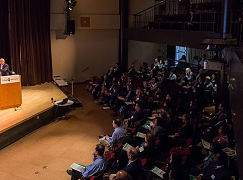Overview
The Lake County Health Department, Illinois, worked with county, business, and community leaders to host a countywide, multisector gathering — the “Together Summit” — to highlight strategic opportunities to work together, share accountability, and leverage investments to improve health for all.
Who Took This On
Lake County Health Department and Community Health Center, IL
Ways You Can Get Started
- Use the MAPP process to facilitate robust community engagement in community health assessment and community health improvement planning
- Develop compelling infographics to share data about health inequities
- Engage in conversations with community leaders and elected officials about their visions for their communities and what resources are needed to achieve that vision
See Advice for Local Health Departments below for more ways to take action.
What Sparked This?
Health Equity Team created
As described in the other Lake County case study, the Lake County Health Department and Community Health Center (LCHD/CHC) used the NACCHO Mobilizing Action through Planning and Partnerships (MAPP) process in 2011–2012 to develop their state-required Community Health Assessment and Community Health Improvement Plan (CHIP). This process resulted in identifying health equity as 1 of 4 strategic priorities. Over the course of 3 years, LCHD/CHC allocated resources to hire a Health Equity Team, which came to fruition in September 2015.
GO Lake County prioritizes upstream work
Guided by the vision of “achieving the highest level of health and wellness for all in Lake County,” Lake County’s 2016–2021 Community Health Assessment and CHIP identified 4 priority health issues: cardiovascular disease and hypertension, obesity, behavioral health (mental health and substance use), and diabetes; and 5 strategic priorities including:
- Improve policies, systems, and environments to promote healthy lifestyles
- Increase physical activity in adults and youth
- Improve and promote nutritional opportunities in the food environment
- Improve clinical interventions for chronic disease
- Improve behavioral health capacity and infrastructure
To help fulfill the Community Health Improvement Plan, LCHD/CHC and their partners in the Live Well Lake County Steering Committee launched the GO Lake County initiative, the goal of which is to “engage the whole community to enhance and increase the shared experience of walking and other forms of active living.”
Pointing to the health and economic benefits of walking, GO Lake County seeks to engage city and municipal planners, public/private partnerships, community groups, parks, schools, businesses, industry, and residents to leverage each sector’s contributions toward improved walkability and health for all. They emphasize that investments in walkability can be leveraged to address other conditions (e.g., food deserts, safety concerns, economic opportunity, etc.) and health outcomes (e.g., diabetes, obesity, mental health), particularly for the most disadvantaged populations.
The Lake County Health Equity Coordinator notes that all 52 municipalities in Lake County will have the opportunity to have their own local version of the GO initiative, which is part of the overarching GO Lake County initiative and involves extensive relationship building and communications. He notes that some municipalities will roll the GO model out with ease, while others will face resource and capacity challenges. LCHD/CHC’s vision is to connect every neighborhood in this rollout and facilitate conversation about the importance of “investing in communities across communities,” and that all communities will benefit from their shared investments to address inequities.
Data highlights Lake County’s wealth and inequities
As one of the wealthiest counties in the United States and intentionally marketed as a very desirable place to live, work, and play, Lake County prides itself on economic well-being, wealth of walking paths and walkable neighborhoods, proximity to nature, and well-performing schools. However, as health data illustrate, not everyone in Lake County benefits equitably. The average age of death in North Chicago is 14 years less than in the Lake Forest community, and there are significant unequal burdens in morbidity and mortality between neighborhoods and racial/ethnic groups.
According to the Health Equity Coordinator, prior to this work, many individuals in Lake County weren’t aware of the disparities in the county. To facilitate conversations about health inequities, LCHD/CHC developed maps to illustrate the distribution of the social determinants of health across neighborhoods, and compelling infographics on the 4 priority health areas identified in the CHIP: diabetes, obesity, cardiovascular health, and behavioral health. Each infographic describes the prevalence of the disease and its economic impacts, and the unequal burdens experienced by people of color compared to Whites. These infographics have been distributed widely across LCHD/CHC and to various community and business stakeholders and elected officials.
LCHD/CHC saw the release of the new data and Community Health Improvement Plan as an opportunity to build awareness and understanding of how all sectors are needed to improve health for all, and how there is a shared responsibility — among businesses/industry, city and county government, social and clinical services, faith communities, schools, families, etc. — to keep everyone healthy. In January 2016, LCHD/CHC staff began planning for the “Together Summit” as a catalyst for the advancement of the Community Health Assessment and Community Health Improvement Plan and addressing identified health inequities.
Program Description
On January 24, 2017, LCHD/CHC and their community partners hosted the “Together Summit.” In total, more than 200 people attended, representing almost half of Lake County’s municipalities and more than 100 organizations from sectors including health care, higher education, law enforcement, and faith communities. The Together Summit agenda and presentations are available online at www.togethersummit.com and www.LiveWellLakeCounty.org.
Speakers use different frames to talk about why investing in health is needed
One of the main goals of the Together Summit was to reach out to politically diverse communities and leaders and engage them in discussions about health equity and the social determinants of health.
- Everyone has a role to play and everyone benefits: LCHD/CHC invited the Lake County Board Chairman, a champion of health equity, to be one of the main speakers. He framed his message around how everyone has a role to play to advance community health, and how everyone benefits from investing in health. He also noted that the county could maximize its outcomes by encouraging organizations to work together, and with the Health Department, to connect the dots around their shared values and vision for Lake County.
- Health is an important part of the economic pitch: Another invited speaker was the President/CEO of Lake County Partners, an economic development corporation responsible for recruiting Fortune 500 companies to move their headquarters to Lake County. The CEO emphasized that health is an important part of the pitch to the corporations that they are trying to recruit. Lake County needs to be as healthy as possible because a sick workforce is not a productive workforce. He also emphasized how Lake County is a great place for both businesses and people, a concept known as the Lake County Promise.
- Using national data to showcase zip code inequities: The keynote speaker was the current Executive Director of the National Institute of Mental Health and Wellness and a former VP of Kaiser Permanente, who discussed what Lake County would look like if leaders and organizations leveraged all of their assets together toward improving community conditions and addressing equity. Drawing on Kaiser’s community investment work, he gave the audience national data to illustrate that one’s zip code has a greater influence on life expectancy than one’s genetic code, and that there are many interventions communities could apply to address those zip code conditions.
- Using local data to showcase life expectancy inequities: LCHD/CHC staff presented health disparities and social determinants data for Lake County, highlighting, for example, maps of how educational and other outcomes relate to life expectancy. The speakers referred to the momentum generated by the creation of Lake County’s CHIP and the Together Summit as the “the opportunity of a lifetime” to address place-based and historical inequities in health. Participants also learned about the Call to Collective Action that had been developed through the community health improvement planning process.
Summit organizers intentionally ordered the speakers’ presentations. As noted by the Health Equity Coordinator, “For that politically diverse audience, my talk could not have been the first talk. But having county leaders go first, then having the Kaiser leader bridge economic context to how zip codes impact health all across the nation, helped create an openness and dialogue that was very powerful.” He noted that the local data and a concrete call to action were critically important for grounding the conversation in the local context and building momentum post-summit.
Call to action to promote shared accountability
LCHD/CHC staff concluded the Together Summit with the Call to Collective Action, stating that alleviating the burden of chronic disease was critical to a shared successful future. Staff proposed 3 specific community health improvement initiatives that “have positive policy, system, and environmental change implications for all of Lake County.” The 3 proposals were:
- Raising the age for purchasing tobacco to 21 (also known as Tobacco 21)
- Improving walkability in Lake County to address obesity and diabetes
- Improving Lake County’s behavioral health capacity and infrastructure
In their summit evaluation, LCHD/CHC staff found that 98% of people surveyed supported 1 or more of the initiatives, and more than 70% of surveyed participants said they would support the initiative in their own municipality.
Intentional framing: All of Lake County cares about all of Lake County
LCHD/CHC staff were intentional in the way they framed their messages to highlight that “all of Lake County cares about all of Lake County.” This messaging was intended to help people think beyond their own zip code and instead think about how everyone has a role to play in addressing inequities. They emphasized that the smaller the disparities between the top and the bottom are, the more everyone benefits.
Outcomes and Impacts
-
Increased momentum for togetherness
Four months after the Summit, participants have gained momentum across socioeconomically diverse communities that are talking to each other in ways that they never had before the Summit. Conversations focus on leveraging resources collectively for communities most in need and that are impacted by the health priorities identified. Other conversations focus on how to support GO Lake County and Tobacco 21 and improving behavioral health infrastructure in local towns and villages. The Health Equity Coordinator notes that although there are 52 different municipalities in their county, there is receptivity and responsiveness to the message of togetherness.
-
Changing the narrative — “Inequities exist, place matters”
As noted by the Health Equity Coordinator, “Just a couple of years ago when we started, many folks didn’t understand that disparities exist in Lake County.” LCHD/CHC intentionally shared data in accessible ways (e.g., in infographics, flyers, and presentations) about how — despite being one of the wealthiest and most successful counties in the nation — they too have notable, preventable inequities. In particular, their maps illustrated the impact of place on health determinants and health outcomes. By highlighting that the largest burden of disease and death is in the lowest income communities, LCHD/CHC is illustrating the importance of working together to address the issues that create these inequities.
-
Changing the narrative – “We all benefit from eliminating inequities”
The Health Equity Team has been intentional in nurturing an inclusive message about how everyone benefits from improving everyone’s health. The Summit was named the Together Summit intentionally to get at the heart of LCHD/CHC’s message.
“We’ve proven that we can’t do this on our own — we have to come together across sectors, across different political persuasions. And we are beginning to see the fruits of that messaging as we see more and more stakeholders get involved and use this framing of togetherness.”
Future Steps
Building on momentum from the Together Summit, LCHD/CHC is advancing community partnerships at the county level and within individual municipalities. Through this work, the Health Equity Team is exploring ways to leverage investments and resources across communities to address the county’s health inequities.
- The Health Equity Team is connecting with every neighborhood to ensure inclusion in the GO Lake County Initiative and frame the conversation as one of shared responsibility, shared accountability, and shared health.
- LCHD/CHC staff are working with municipalities to develop local/context-specific data that can be used in efforts to improve community conditions and health.
- The Health Equity Team is also exploring additional cross-community policy opportunities to address mental health in Lake County.
Advice for Local Health Departments
-
Listening is critically important
One of the most important aspects of building trust with others — whether the CEO of a major corporation or the sick grandmother living in public housing — is listening. Making sure that everyone’s voice is heard and reflected in the dialogue moving forward is a critically important part of building a sense of trust and honor across the community. See the other Lake County case study for their ABCs of Community Relationship Building to illustrate how they approach this listening.
-
Map data to show how place matters
Mapping data on employment, education, food security, and other social determinants of health helps to increase awareness and understanding about the larger story and why a Place Matters framework could benefit your community.
-
Develop a shared assessment
Communication is critical for developing a shared assessment of what’s really happening in communities. The health department can bring data and maps, but external community partners are needed to collectively understand the reality, the most pressing health inequities, and how those inequities came to be. Pairing data with the personal stories of those impacted by disparities is very powerful for developing shared understanding and momentum for change.
-
Tailor your message to your audience
LCHD/CHC leads with a message about investing in the future, making investments to benefit the workforce, and having shared accountability across sectors. The RWJF Culture of Health framework can be a helpful tool for determining the right message for your audience. Engaging in conversations and working with politically diverse communities is critical, but also requires a lot of preparation, clarity of purpose, patience, and follow up.









